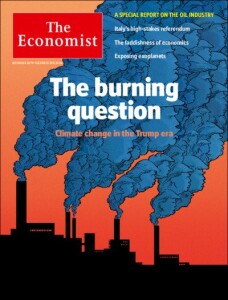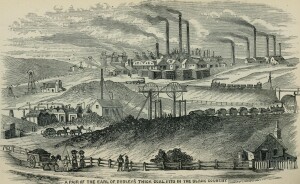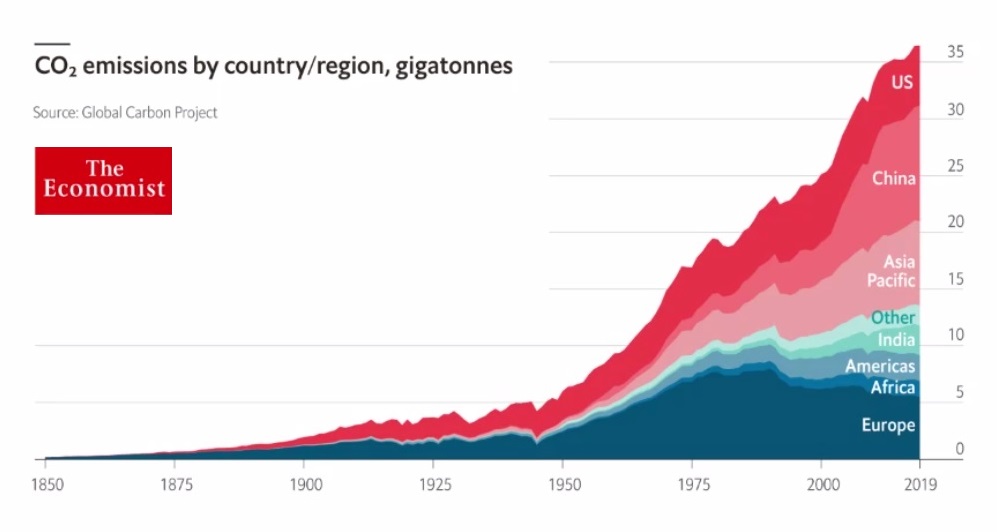Raging, uncontrollable forest fires. Prolonged heat domes, causing hundreds of deaths. Catastrophic storms. Flash floods. These are just a few of the effects of climate change being felt this year. Are the countries of the world acting quickly enough to prevent irreversible damage?
Two months ahead of the upcoming COP26 negotiations in Glasgow, two editors from the magazine the Economist discussed their expectations of this crucial conference in a webinar on September 23, 2021, before an audience of hundreds. Oliver Morton, the Economist’s Briefings senior editor, and Catherine Brahic, Environment editor, discussed the recent findings of the latest Intergovernmental Panel on Climate Change (IPCC) report which have delivered the starkest warning yet about climate change.
“This report unequivocally linked climate change to human greenhouse gas emissions,” Morton said. “Ten years ago, questions about attribution began, but increasingly we are seeing events that can be linked to climate change. The recent northwest heat wave was definitely linked. Also, the 2019 fires would not have happened, except for climate change.”
In 1988 the atmospheric scientist James Hansen first testified before the U.S. Senate that “he was ninety-nine percent certain the earth was warmer then than it had ever been measured to be, there was a clear cause and effect relationship with the greenhouse effect and lastly that due to global warming, the likelihood of freak weather was steadily increasing.”
In 2010, Morton said, the IPCC said that, no matter what change is made, humanity will have to adapt to higher temperatures. “Al Gore objected to this ‘climate surrender.’”
Climate change is “unlike anything else,” Morton said. “People are extremely powerful—it is we who are changing the geoscience—yet we feel totally impotent,” because we can’t stop the earth from heating up. Earth has entered the Anthropocene epoch: “we are a force of nature, yet we are uncontrollable.”
The “cli-fi” novel The Ministry for the Future by Kim Stanley Robinson “opens with a cataclysmic event” that gives an example of what’s in store for us.
“The sad truth is that [the attention paid to climate change] depends on where, when and to whom the events happen,” said Catherine Brahic. “Floods in Germany… fires in Canada and the U.S. To date, we had assumed these countries were shielded” from the worst effects of climate change.
“There is a lot of build-up to the COP 26 conference,” she said. “There is a stark difference between the events this year and, say, when a small, unimportant nation such as the Philippines had to deal with the catastrophic Hurricane Haiyan” (Yolanda) in 2013.
“Humans knowing things” must be done about climate change “does not mean that humans will do something,” Morton said. “There is no world power to make people do what actually needs to be done.”
It may be naïve to expect COP 26 will achieve very much, “but imperfect solutions can still have some effect. Some nations will make a difference,” he said. “When the gap is noted, people can start to chip away at it.” He believes that once people learn it’s possible to decarbonize, they will become engaged in a “self-catalyzing virtuous race.”
As an example, he cited the smog situation in the nineteenth century. A recent paper by Timothy Hatton states that a century ago, “coal-fired industrialization in Europe spawned factories that belched black smoke, with little government regulation. Black smoke from these emissions was in the order of 50 times higher than today. Partly for this reason, urban centres had much higher mortality rates than rural areas. Indeed, there is evidence that the mortality gradient by industrial emissions was steeper in 19th century Britain than it is in China today.”
“The Paris agreement is an incredibly complex mechanism,” Brahic said. “Governments must come back every five years to take stock.” There is a “ratchet mechanism” in place. Although nations “can’t reach the 1.5-to-2.5-degree target, the political pressure is building, and technology is improving.”
She pointed to the CO2 emissions by country. “China’s emissions need to fall… more than anyone else’s.”
There are some countries that are “leading the way” as far as COP 26 goals are concerned. Morton said Gambia, the U.K., and Sweden are “not too bad.” He referred the audience to the Climate Action Tracker, which evaluates country by country their actions to mitigate climate change.
Morton called on governments to enact more policies to counteract climate change, such as “making land available for solar panels or train tracks.” He praised recent efforts to make solar power affordable. Governments should implement carbon pricing.
“Microsoft has set a net-zero target over its entire history,” Brahic said. Other companies are figuring out “you can’t offset carbon forever. Mitigation is unavoidable.”
She also noted certain industries cannot avoid adding to the CO2 problem: aviation, shipping, steel and concrete industries.
“It’s important to counteract the sense of hopelessness the average person might feel,” Brahic said. “We have more leverage than simply the four walls of our house.” For example, we choose the government that makes choices for the agricultural system and the power infrastructure.
The energy technology that is the most promising so far is “solar power, which is outperforming expectations,” Morton said. “It builds a virtuous cycle. As the grid gets greener, things become greener and cheaper.”♠️
The air pollution graphic is from Griffiths, Samuel, editor of “The London Iron Trade Exchange” (1873).
The CO2 emissions plot per country is from the Economist.
The map of the world colour-coded for action on climate change is from the Climate Change Tracker website.
Permissions pending.
UPDATE: click here to view the November posting about COP 26






